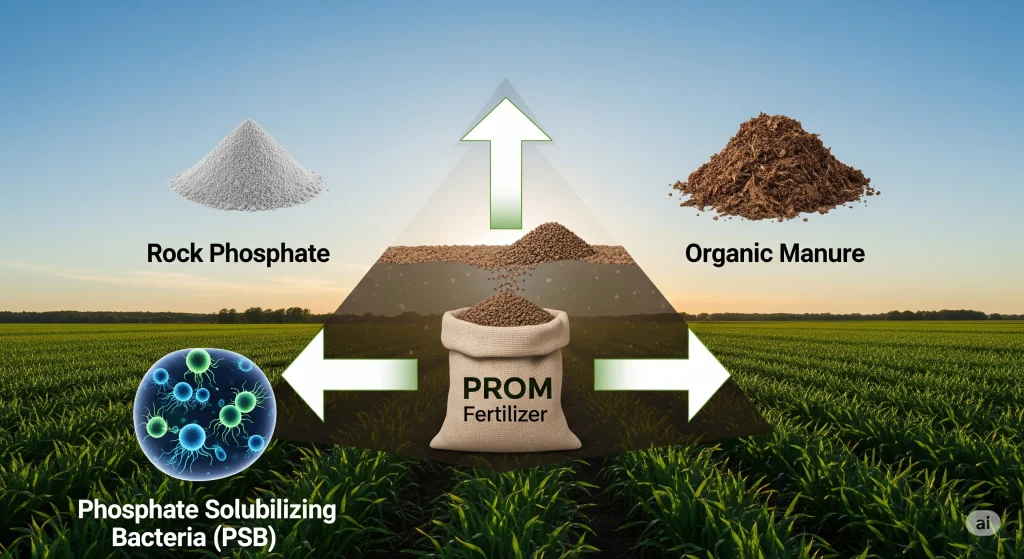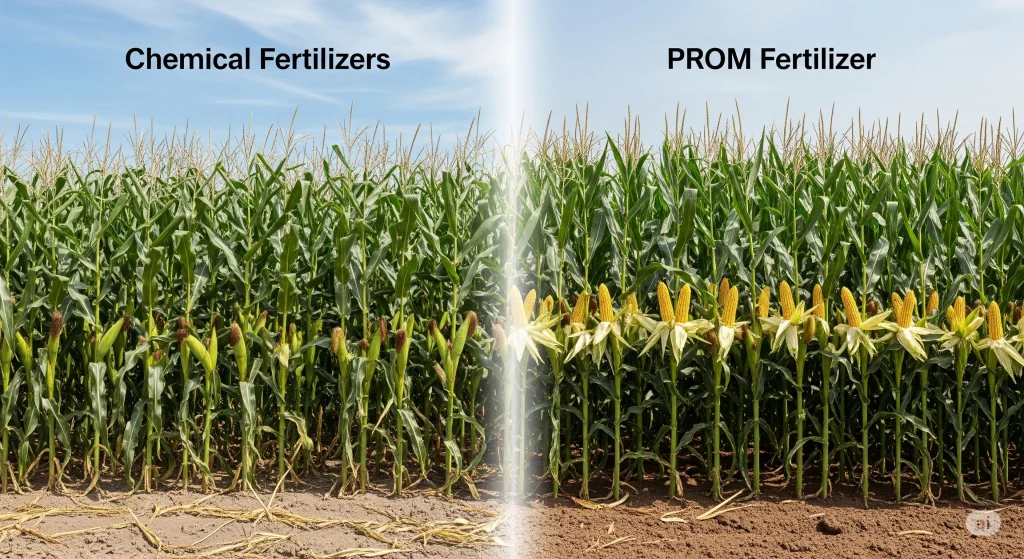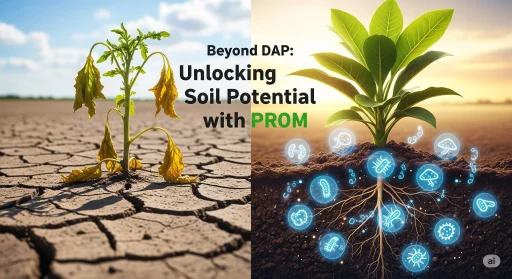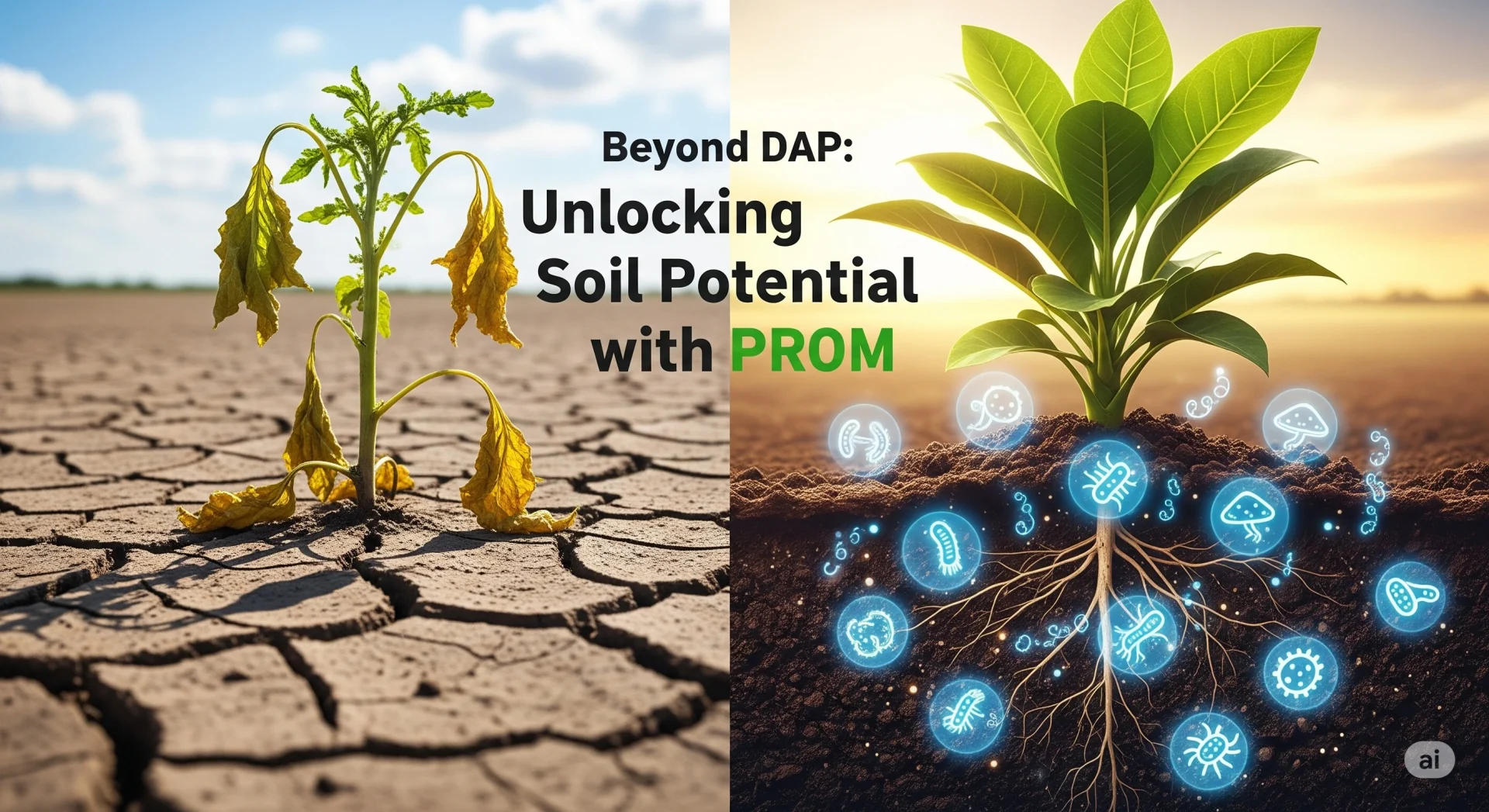Modern agriculture faces a major challenge: feeding a growing global population without destroying the soils that support us. Since the 1950s, farmers have used chemical fertilizers as a way to increase crop yields. The most important is phosphate. This primary nutrient is essential for plant growth and root development. Their overuse comes at a price.
These chemical fertilizers have a reputation for being inefficient. Only a small portion of the phosphate applied to soil is absorbed by plants (around 15-20%). The majority of the phosphate reacts with minerals in soil and is “fixed” (or locked) so that it cannot be used by crops. It is not only a waste of money, but it also causes soil hardening and a decrease in microbiology, as well as environmental pollution from nutrient runoff.
Phosphate-Rich Organic Manure (PROM) is a more intelligent, sustainable solution to this growing problem. This revolutionary fertilizer represents a shift in the way nutrient management is done. This innovative fertilizer represents a paradigm shift in nutrient management.

What is the PROM?
The three components of PROM, each with a different role, work together to produce a fertilizer that is eco-friendly and high in value.
1. High-Grade Phosphate is the main source of phosphorus for PROM. The rock phosphate that is mined is rich in phosphorus. However, it is not soluble in water and is therefore not a good fertilizer. PROM’s core innovation is to unlock the vast and inaccessible reserves of phosphorus.
Read More: How to Start Manufacturing Business of DAP-PROM Fertilizer
2. The organic backbone is Organic Manure. You can use a wide range of organic materials, including:
- Press mud is a by-product of the sugar industry.
- Composted cow dung
- Poultry manure
- Crop residues, such as straw and husks
- City compost
Organic matter has multiple functions. It is a source of food for microbes that are beneficial, it improves the soil structure, it enhances water retention and provides macro- and micronutrients. It is important to note that during the composting, it produces humic acids and fulvic acid. These organic acids chelate the phosphate molecules to prevent them from being locked in the soil. They also ensure their slow and steady release.
Read Our Book: Manufacture Of Biofertilizer And Organic Farming (2nd Edition)
3. The microorganisms behind PROM are Phosphate-Solubilizing Bacteria, or PSB. PSB is a grouping of beneficial bacteria (like Pseudomonas and Aspergillus), and fungi that are capable of converting insoluble rock-phosphate to a form plants can use. The bacteria and fungi are added to the mixture of organic matter with rock phosphate during the manufacturing process. They multiply in the soil and produce organic acids, such as citric and gluconic acid, which dissolve the rock-phosphate particles. This releases a constant stream of soluble plant phosphate at the root zone.

The PROM Manufacturing Process – From Rock to Rich Manure
PROM production is a biochemical process that mimics the natural nutrient cycle and speeds it up.
- Preparation and Selection: The rock phosphate must be of high quality and is ground to a fine powder in order to increase its surface area and make it more accessible to microbes. The organic matter chosen is prepared, and may need to be shredded.
- Mixing The rock phosphate powder and organic matter is mixed according to scientifically determined ratios. The goal is to create an environment that will allow the composting to start.
- Inoculation: An effective consortium of Phosphate Solubilizing bacteria (PSB) are uniformly sprayed into the pile. This increases the population of key microbes that are needed to drive the process.
- Composting Aerobically: A mixture is piled up into windrows, which are long piles. The pile is then subjected to aerobic decomposition. This occurs when microbes breakdown the organic matter while oxygen is present. The heat generated by this process helps to kill pathogens and weed seeds. The piles are mechanically turned at regular intervals in order to maintain optimal temperatures, ensure uniform composting, and ensure proper aeration.
- Curing & Maturation: The most critical phase lasts for several weeks. During this time, PSBs multiply exponentially. They feed on organic matter, and secrete acid continuously that dissolves the rock phosphate. This converts the insoluble phosphorus to a form available for use.
- Sieving & Packaging: After the composting is completed and the material is a dark crumbly manure with an earthy smell, the product is sieved for a uniform grain size. The product is tested to ensure it meets quality standards before packaging.
Read Our Project Report: Click Here
Compare and contrast: Why PROM is superior to DAP/SSP
The benefits of PROM over chemical phosphate fertilizers are numerous and significant.
| Features | Conventional Fertilizers (DAP/SSP) | PROM (Phosphate-Rich Organic Manure) |
| Nutrient Efficiency | Very Low (15-20%). The soil will lock up most of the phosphorus within a few weeks. | Very high (up to 70%) The organic matter protects phosphorus and PSBs provide a continuous, slow release. |
| Mechanism for Release | Fast Release. The plant is unable to fully utilize the large amounts of soluble phosphate released all at once. | Slow and steady release. The plant releases nutrients gradually, as it needs them. This minimizes waste and fixes. |
| Impact on Soil Health | Negative. Negative. | Très Positive. Highly Positive. |
| Nutrient Profile | In DAP’s situation, it mainly provides Phosphorus (and Nitrogen). Other essential nutrients are lacking. | Phosphorus, organic carbon, nitrogen, and other essential secondary and micronutrients are all included in the organic manure. |
| Environmental Impact | Eutrophication and algal blooms are possible as a result of high nutrient runoff. | Eco-friendly. Minimizes nutrient runoff. Use of organic wastes promotes a circular economic system. |
| Cost-Effectiveness | Initial costs may seem low, but soil degradation and high waste rates will lead to higher long term costs. | Its high efficiency reduces the amount of bags needed. It is highly cost-effective because the soil health benefits will reduce your need for other inputs. |
| Suitability | It is less effective in soils that are highly acidic or high alkaline, where the problem of fixation is severe. | The PSBs and organic matter work together to provide phosphate in any soil type. |
Read More: Production of PROM (Phosphate Rich Organic Manure)
PROM in the Indian Context
The Government of India, recognizing its enormous potential, has included PROM officially in the Fertilizer Control Order (FCO) of 1985. The FCO gives PROM legal status, and sets strict quality standards for manufacturers to adhere to. According to the FCO, these are the key specifications:
- Total Phosphate Minimum 10.4%
- Organic Carbon: Minimum 7.9%
- Moisture: Maximum 25%
Promoting PROM is an important component of India’s National Missions on Sustainable Agriculture and Soil Health, since it perfectly aligns with the goals to reduce chemical fertilizer dependence and improve soil fertility for long term food security.
Want To Know About Which Business Idea Would Be Better For You?
Go Through Our Startup Selector Tool
Conclusion
Phosphate Rich Organic Manure is more than just a fertilizer. It is an integrated system that supports soil life. It bridges the divide between high-yield farming and ecological sustainability. PROM is a solution that uses the power of the natural world to overcome the limitations of chemical fertilizers. It combines organic matter with minerals and microbes. It feeds both the crop and the soil at the same time, creating a cycle of productivity and fertility. In a country like India that faces dual pressures to ensure food security while preserving natural resources, PROM does not just represent an alternative, it’s the future of intelligent, responsible nutrient-management.
PROM Fertilizer: FAQs (Frequently Asked Questions)
Q1 – Is PROM an organic fertilizer?
PROM is a completely organic fertilizer that is approved for organic farming. All its components (rock-phosphate and organic matter) must be sourced from acceptable inputs.
Q2 – Can DAP completely replace PROM in my field?
PROM is a better and more effective alternative to DAP for the phosphorus requirements of the crop. Farmers must also remember that DAP contains nitrogen. When switching to PROM, nitrogen requirements of the crop will need to be met by other sources, such as urea or compost.
Q3 – When and how should I use PROM?
It is recommended that PROM be applied in a low dose during soil preparation and just before planting or transplanting. The general recommendation is between 100 and 200 kg per acre. However, the exact dose should be determined by a soil testing report to ensure optimal results.
Q4 – Will I see results after the first season?
The efficient supply of Phosphorus will result in improved crop growth and yields from the first season. The most significant benefits of PROM, such as the improvement in soil structure and water retention and overall fertility, are cumulative and will become apparent after a few crops cycles.
Q5 – Is PROM cheaper than DAP or not?
The price of PROM per bag can be similar to DAP or even slightly higher. Its true value is in its efficiency. You get more bang for your buck because less phosphorus gets wasted. PROM has a much higher cost-effectiveness when you consider the benefits of soil health over the long term and the need to use less other corrective chemicals.







